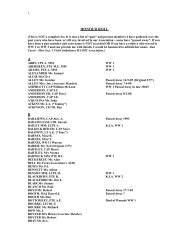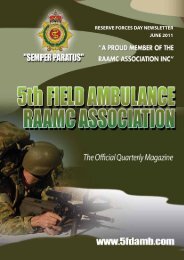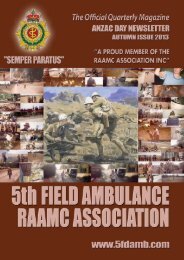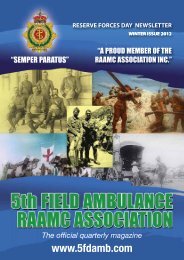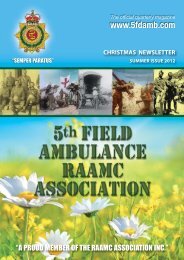2010 Paulatim Magazine - RAAMC Association
2010 Paulatim Magazine - RAAMC Association
2010 Paulatim Magazine - RAAMC Association
Create successful ePaper yourself
Turn your PDF publications into a flip-book with our unique Google optimized e-Paper software.
Veterinarians in the Australian Military<br />
Until it was disbanded at the end of WWII, there was a Veterinary corps<br />
providing care to the military horses and other animals. There are now<br />
but a handful of Veterinarians in the military, most of whom are<br />
reservists, and fall under the <strong>RAAMC</strong> banner. Apart from the novelty<br />
factor, uniformed veterinarians currently undertake a number of tasks<br />
but are largely underutilised. There are two reservist Veterinary Officer<br />
positions at the Army Malaria Institute (AMI) caring for the colony of<br />
Aotus monkeys. These monkeys do not suffer malaria like humans do<br />
as they will self-clear the parasite.<br />
Other Veterinarians are<br />
present within the military in<br />
non-Veterinary positions but<br />
provide input into Exercises<br />
such as AACAP and Pacific<br />
Partnership, as well as<br />
assistance to Military Working<br />
Dogs (MWD) and unit<br />
mascots.<br />
Every year a Veterinary Officer attends AACAP. In <strong>2010</strong> was held in<br />
Ernabella (Pukatja to the locals) and was attended by two<br />
Veterinarians: MAJ Amanda Parry and CAPT John Hunter. The primary<br />
aim of veterinary involvement was to desex as many of the local dogs<br />
as possible and euthanise some animals to aid in population control.<br />
This was done in a makeshift ‘surgery’ with an FS table for our surgery<br />
table. The efforts of the construction team were greatly appreciated<br />
after they made some leg extensions for the tables to raise the height<br />
and save our backs as we performed surgery. We were also ably<br />
assisted by our dog wrangling team: CPL Seton Wardrop and especially<br />
LT Stacey Lawrence , an EHO who took up the challenge of being our<br />
nurse come anaesthetist and did the job brilliantly!<br />
Another activity we were involved in was the US-lead Exercise Pacific<br />
Partnership which provides health care, including veterinary assistance,<br />
to the south pacific region each year. AS involvement in PP 09 was<br />
limited due to the outbreak of Swine Flu, however LT Garnett Hall<br />
participated in PP 10. LT Hall is currently deployed on OP Astute and<br />
attended the Timor Leste phase of PP10 in August as part of a<br />
veterinary team. In addition to providing small animal veterinary<br />
services, the veterinary teams travelled to regional communities to<br />
treat livestock, and assisted in the investigation of a disease outbreak.<br />
With the ever-present threat of IEDs in Afghanistan, our Explosive<br />
Detection Dogs (EDD) are becoming a much more important asset.<br />
Veterinary care on deployments is largely reliant on coalition<br />
veterinarians or health personnel.<br />
I am currently working within the<br />
health cell of 1 Div and in<br />
conjunction with SME am developing<br />
veterinary policies for our MWD to<br />
improve the care of our canine<br />
soldiers. I welcome any input from<br />
members and health personnel who<br />
have had experiences caring for<br />
MWD.<br />
In addition to surgery we conducted general examinations, house calls<br />
and parasite control. The two local donkeys who had the run of the<br />
town were spared from the scalpel.<br />
For any veterinary matters contact<br />
MAJ Parry, HQ 1 Div or email<br />
amanda.parry@defence.gov.au.<br />
By: MAJ Amanda Parry<br />
1 0 2 P A U L AT I M – M A GAZINE O F T HE R OYA L A U S T R A L I A N A R M Y M E DICAL C O R P S – 2 0 1 0



